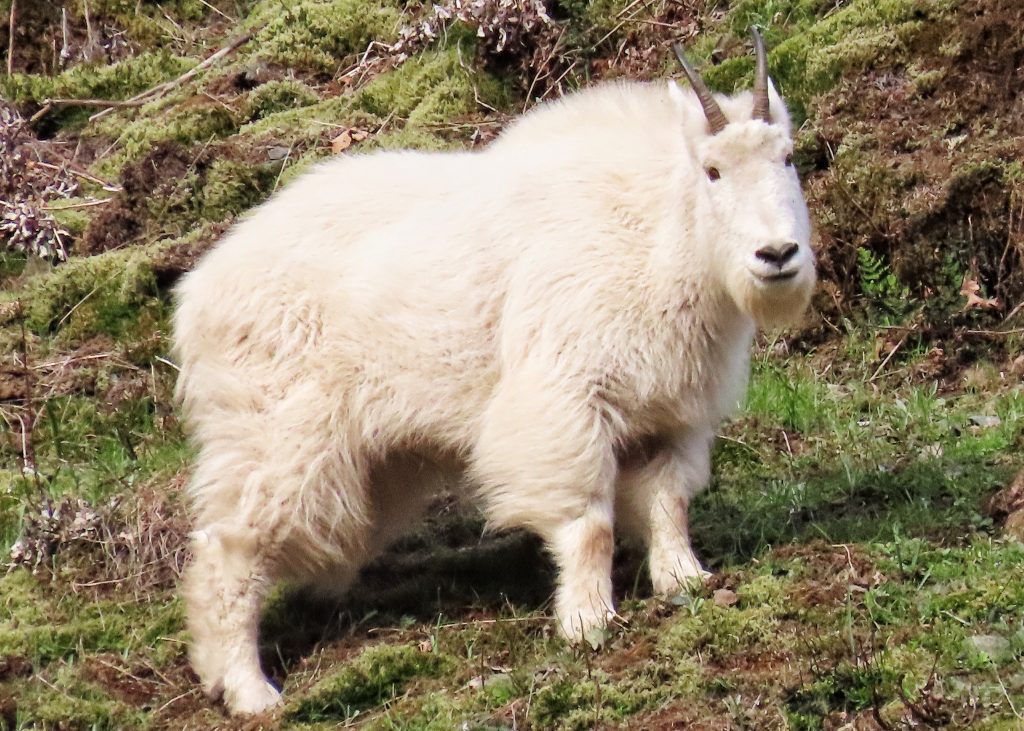
Early this winter I heard that folks were seeing a Mountain Goat in the Columbia River Gorge. I had heard other stories like this over the years, and my friend Craig Sondergaard had seen some in the Gorge last century. I knew there had been reintroductions (an idea based on Merriwether Lewis’ account of Chinook tales told to him on his expedition with William Clark, since by the time settlers came into the area they had been extirpated), but I thought they had failed.
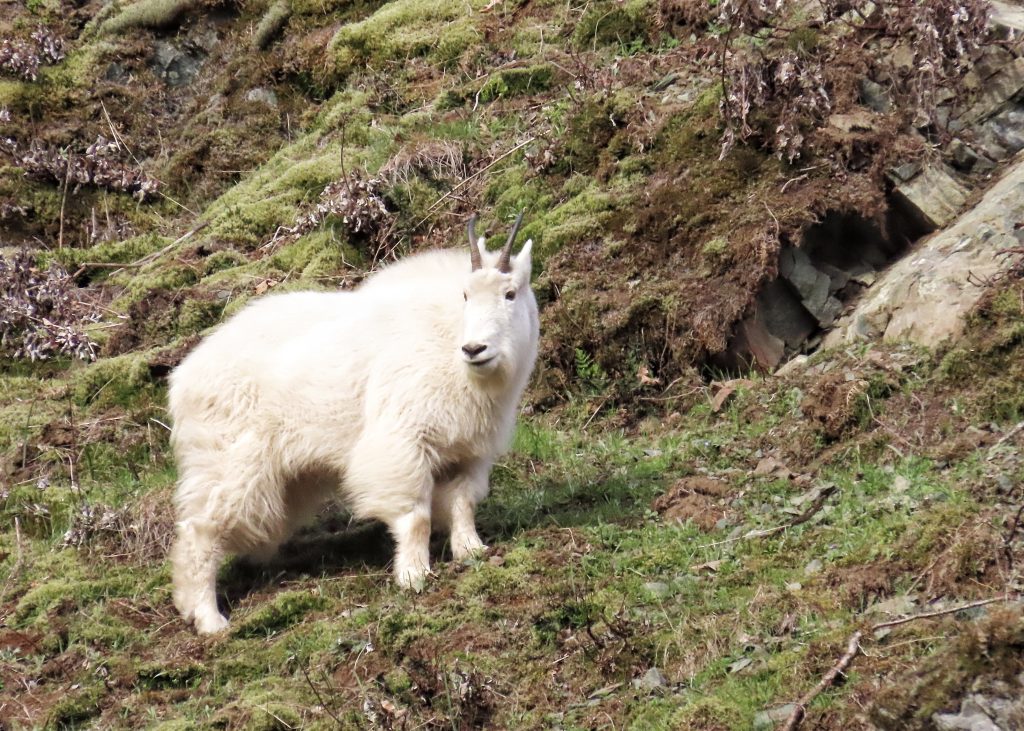
I found out that the Mountain Goat, nicknamed Sweeney by the locals because she (as gendered by a wildlife biologist who recognized that the narrow, widespread horns belonged to a female) had taken up residence in an area of SR 14 known as Sweeney’s Corners, was frequently visible on a steep, open hillside north of the highway, midway between Stevenson and the Carson cutoff, usually in mid-afternoon.
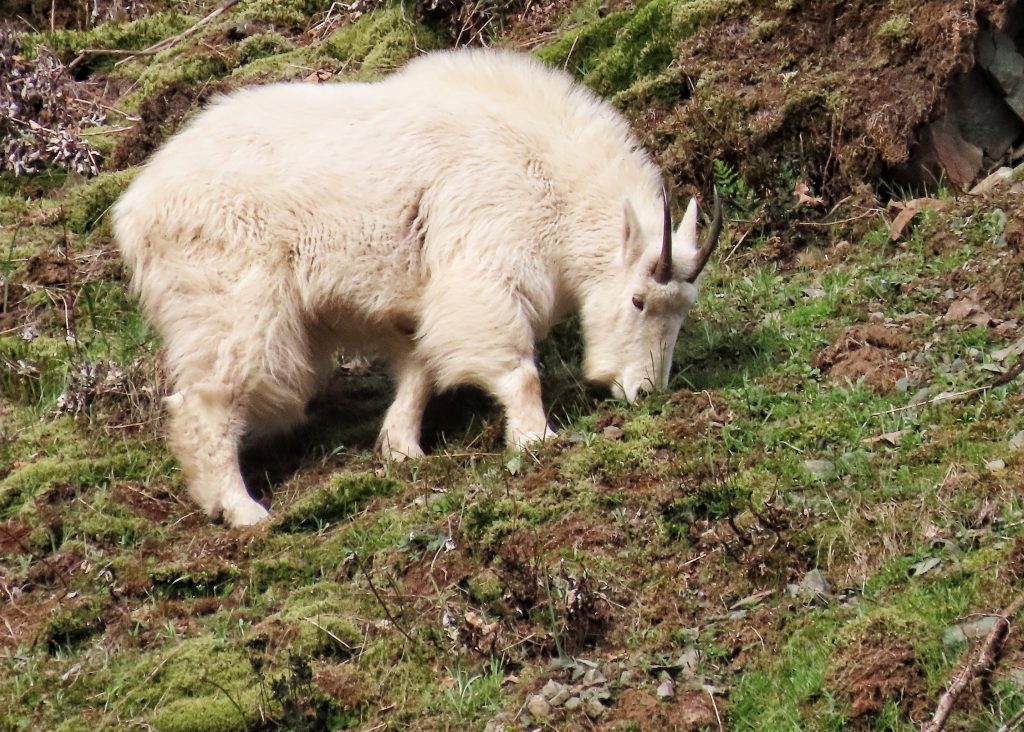
So my wife Pam and I (and then in the weeks to come my nbo Morgan and I, then again with Pam, and then a solo trip by myself), ventured east to look for Sweeney and other cool lifeforms, stopping at the pullout to scan the hillside on the trip east, and stopping again when heading back home. Nada. And when Morgan and I drove to Catherine Creek last Saturday we faithfully stopped to scan the empty-of-large-white-mammals hillside. On the journey home I almost crossed the bridge at Hood River for the more streamlined driving along I-84, but then just kept barreling down SR 14 when I came to that junction, mostly because it was prime time, and I really wanted to see that animal.
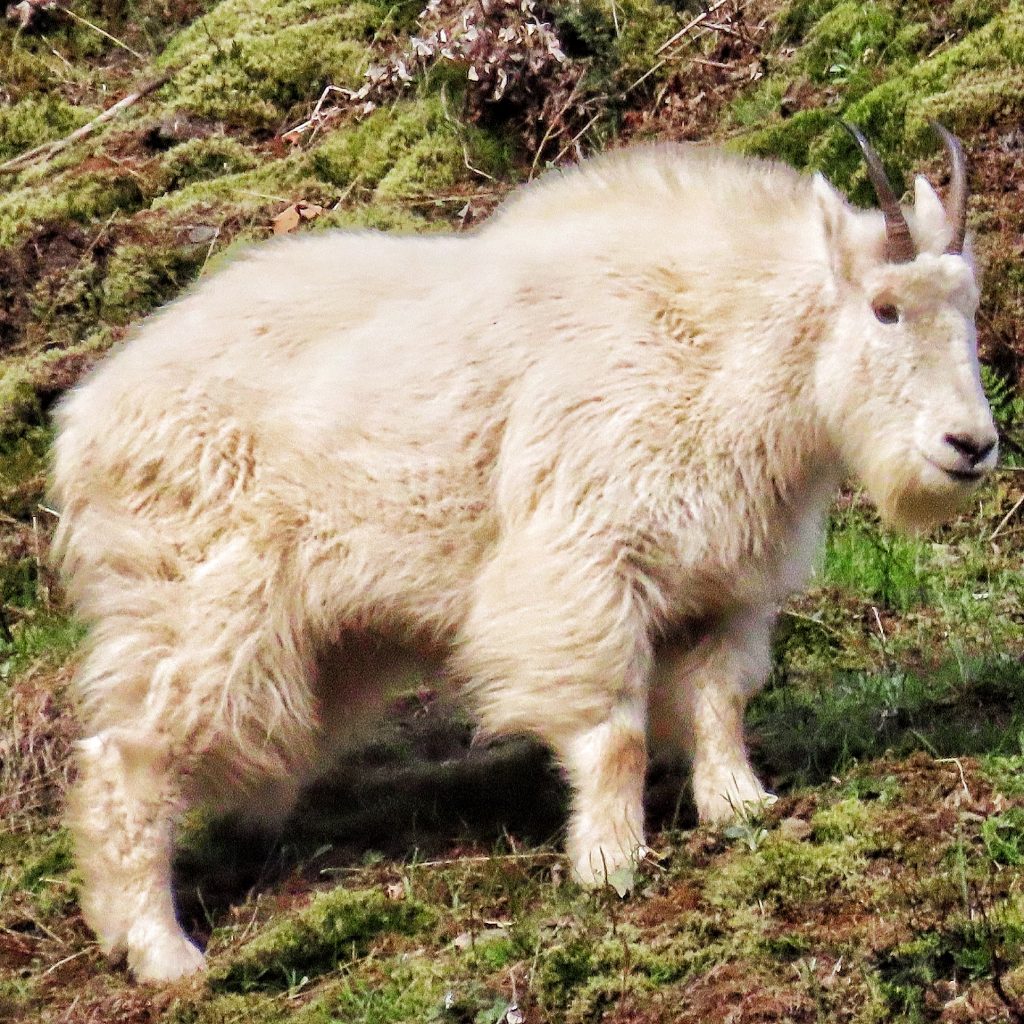
Before I saw the Mountain Goat I knew it must be out, because there were several cars parked below the hillside, and at least a dozen people, most of them with optics of some sort held to their eyes. Then Morgan shouted ‘My god it’s huge’ and I pulled over. While huge may have been a bit of an overstatement, it was an understandable one, since the presence of Sweeney occupied a far larger space than the corporeal body did.
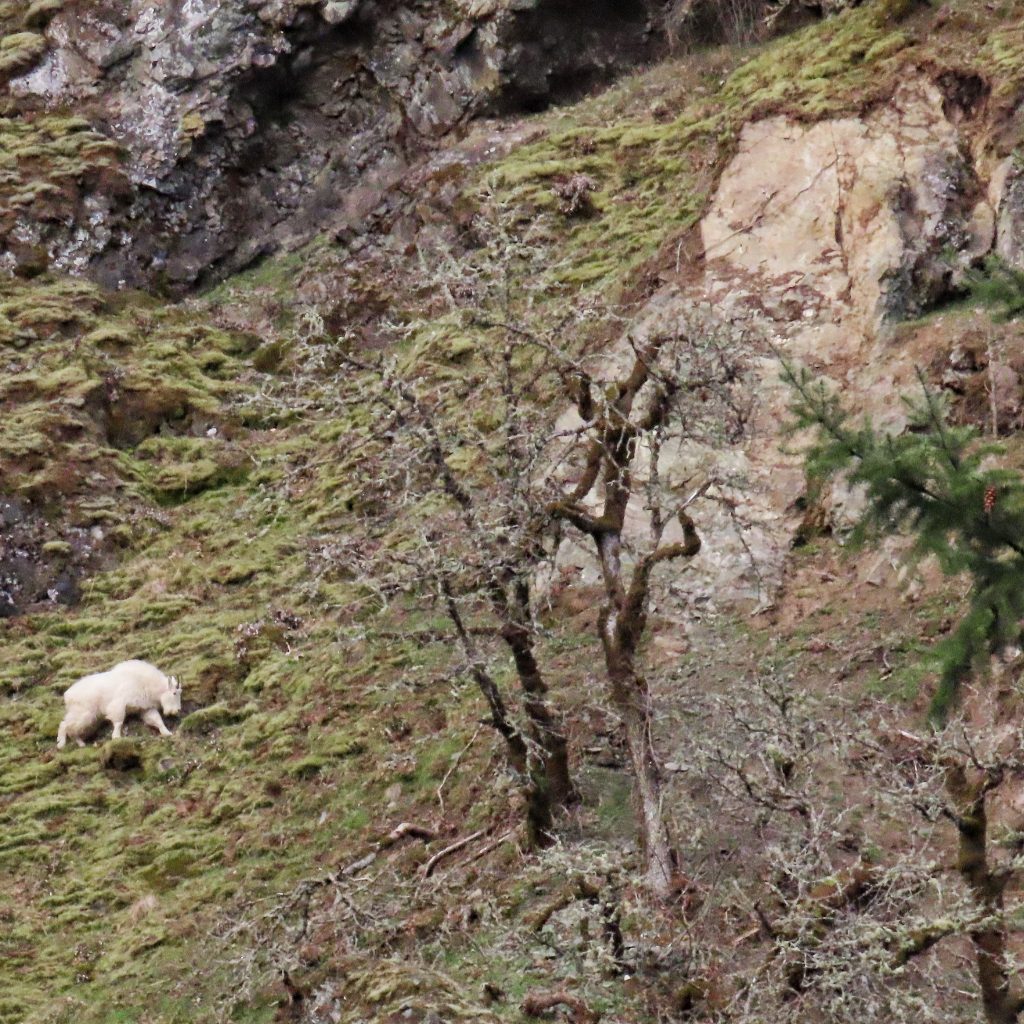
I had seen Mountain Goats before, but except for a fleeting glimpse, at highway speed in a area with no pullouts, of one running across a roadside knoll in the Tetons, I had never been within a quarter mile of one. In fact most of them, unless I happened to have binoculars, weren’t truly recognizable as Mountain Goats except by inference (‘well, those white dots across the canyon are moving, so they must be Mountain Goats’).
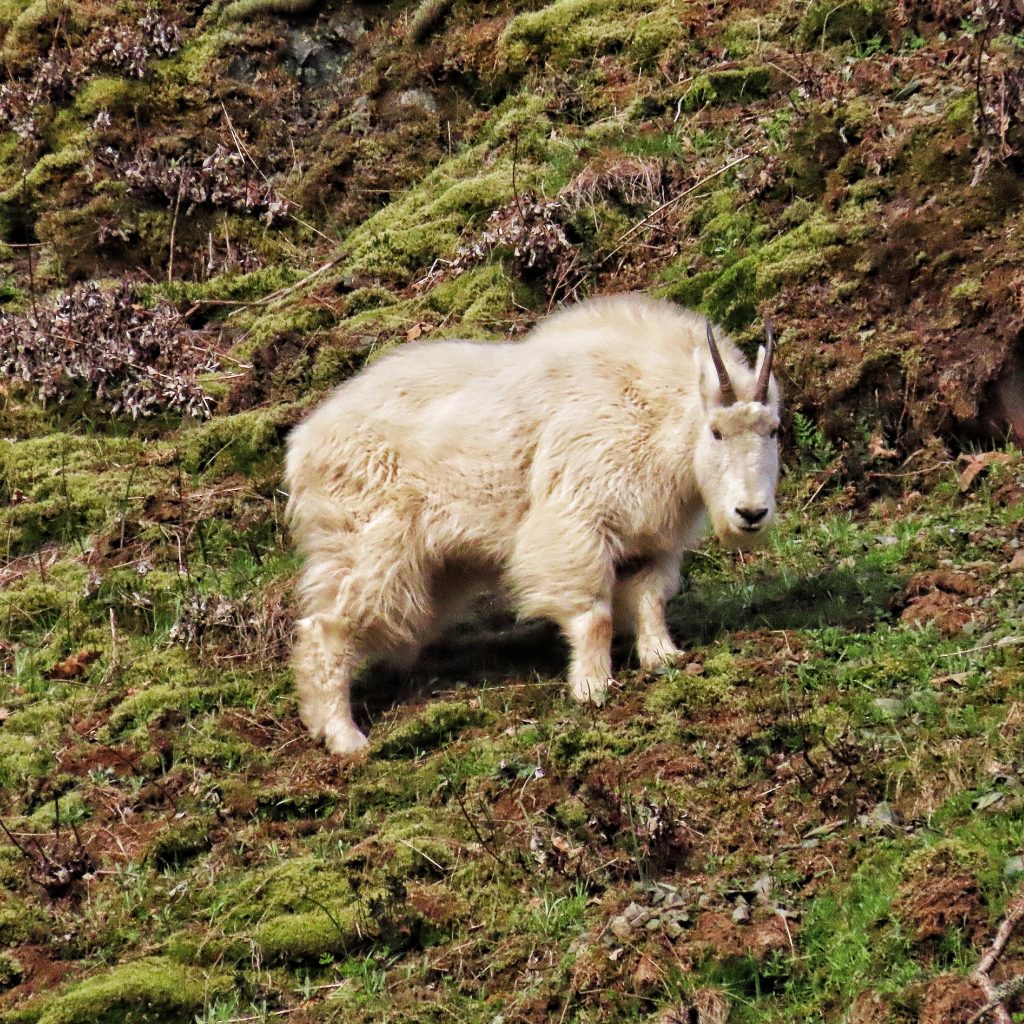
But Sweeney was just hanging out, grabbing mouthfuls of browse and occasionally looking quizzically at the bipeds below, probably not more than 100 yards from the edge of the highway. Even without optics you could see the wind ruffling her fur, which, while not pure white, still contrasted so sharply with the backdrop as to almost glow. It was nearly a holy moment, which I celebrated by taking waaay too many photographs, a bit of gluttony I’ve come to regret during the editing process.
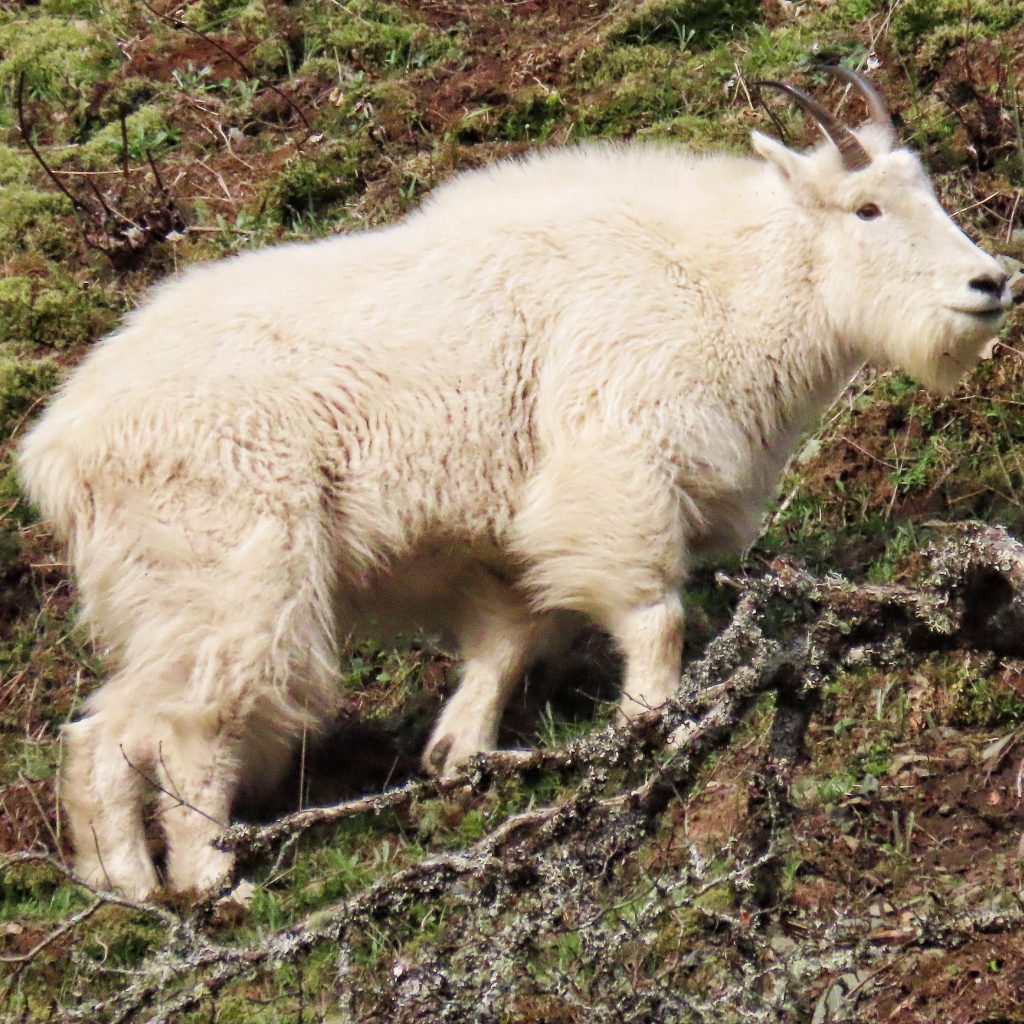
I say nearly a holy moment, because it was tinged with sadness over the solitary life of Sweeney. For an animal as social as a Mountain Goat nanny the lack of company has to leave some kind of void. And the fact that the reintroduction has apparently failed, that we cannot undo the tragedy of that anthropogenic extirpation, leaves a void in me also.
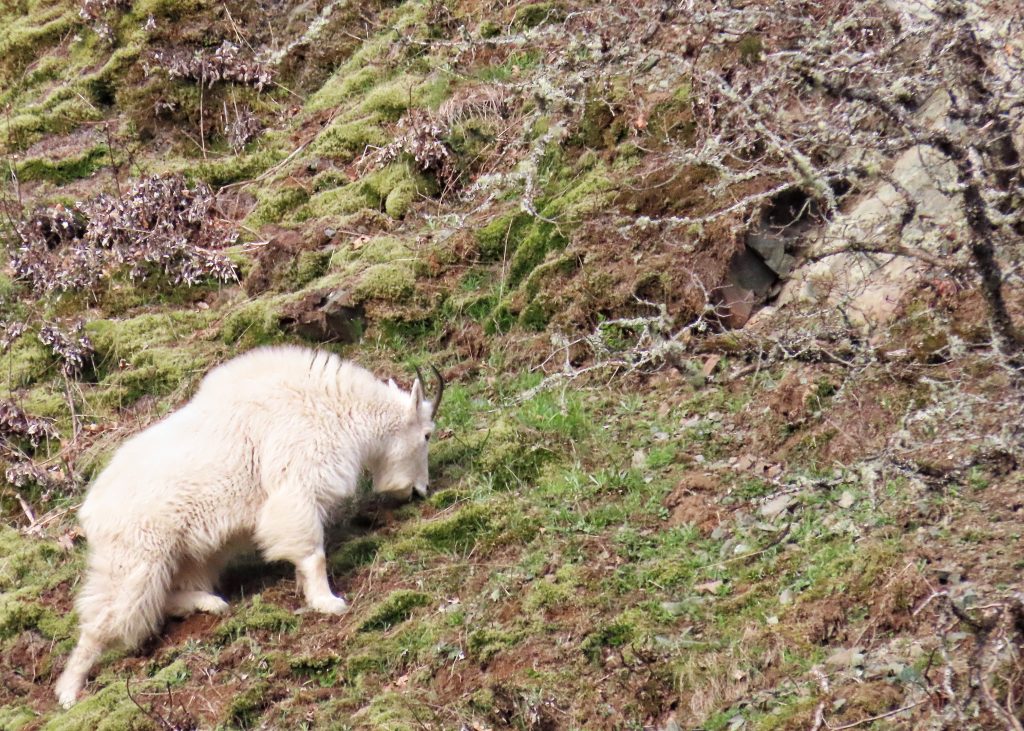
In yet another example of the inaccuracy and inadequacy of common names (though this one is certainly standardized), the Mountain Goat is not a true goat. Instead of being classified with the true goats in the genus Capra, it is the only species in Oreamnos. It is more properly called a goat antelope, and its closest relatives are the chamois (Rupicapra) of Europe, and the takin (Budorcas taxicolor) of the Himalayas. In fact it is much more closely related to the true antelopes of Africa than are our Pronghorn ‘antelope’.
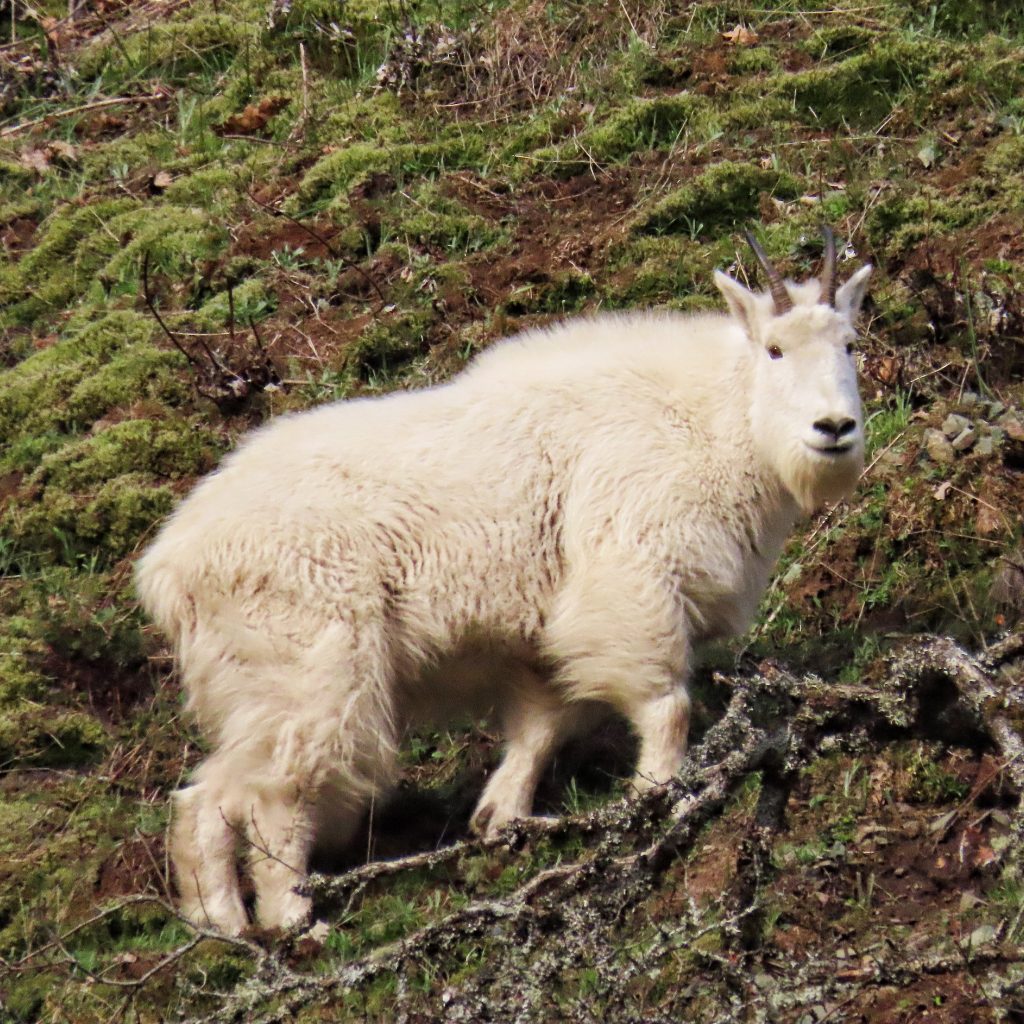
The extremely muscular and powerful neck of Oreamnos americanus is not an adaptation for head butting, as it is in wild sheep, but it is partly a defensive tool. Rather than butting, Mountain Goats will rip and rake with their saber-like horns when threatened, and that musculature adds power to those blows, which is why you also see those heavy necks in nannies, who are called upon to use their horns to defend their kids. Adults are fierce and fearless, and a hiker in Olympic National Park was gored in the leg, and subsequently bled to death, by one that objected to the man attempting to shoo it away.
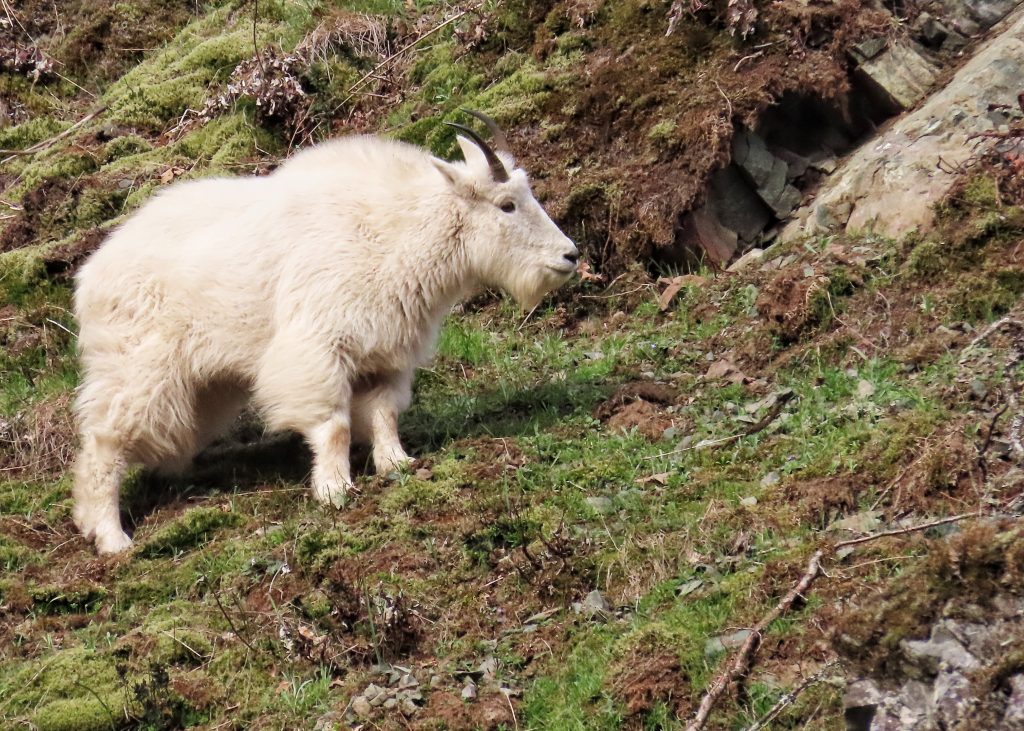
Because of these horn’s potential to inflict lethal injuries, most battles over territory or dominance amongst their own species are primarily threat postures, and usually end with one party showing submission by stretching out close to the ground. During the rut males do engage in physical battles, but in them they stand side by side and rip at each other’s flanks, where they have evolved a thicker, tougher skin to withstand this abuse.
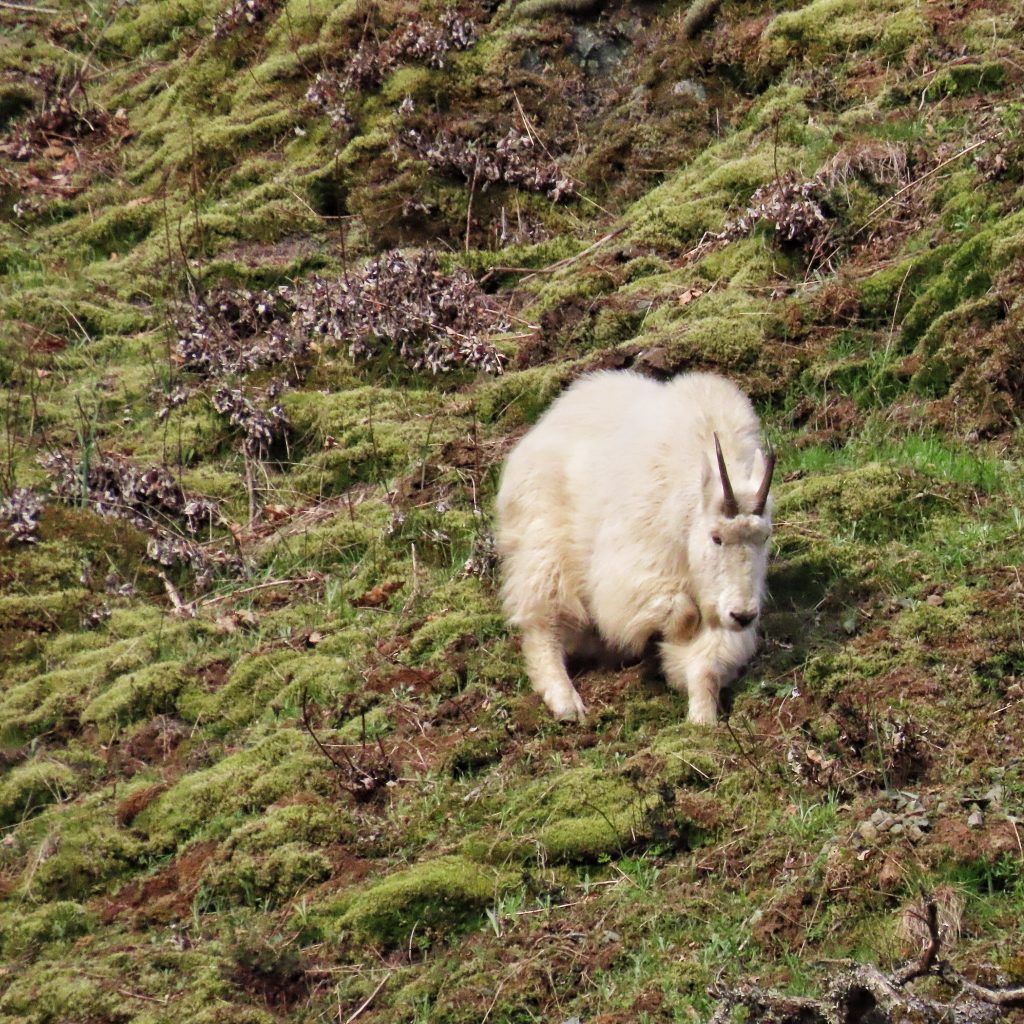
The muscular neck is, oddly to my perception, also of great value when they are climbing steep, even nearly vertical, rock. According to this study, Mountain Goats can apparently ‘lock’ the scapular/humeral angle, and the neck then aids the front shoulders in their ability to pull the animal up a very steep slope, and also helps to regulate their balance. But none of that would matter without the adaptations of their amazing hooves.
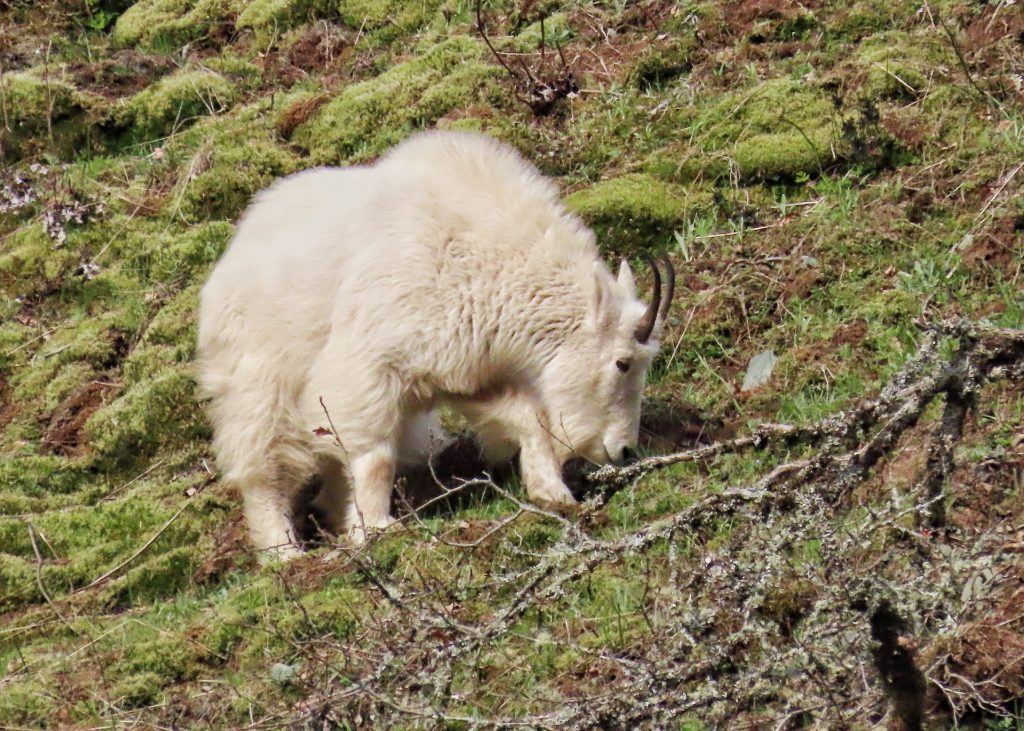
The first key trait of their hooves as regards their climbing ability is that it is very hard on the outside, which allows them to stand on tiny ledges. When I first started rock climbing I used stiff soled hiking boots, which enabled me to ‘edge’ on small holds. The same principle is at work for the Mountain Goats. They also have rough, spongy pads in the middle, which give them great friction on the rock. This is akin to the soft rubber soled shoes that most human rock climbers use today. And finally the two toes of the hoof can be spread and contracted to grip the surface of the rock.
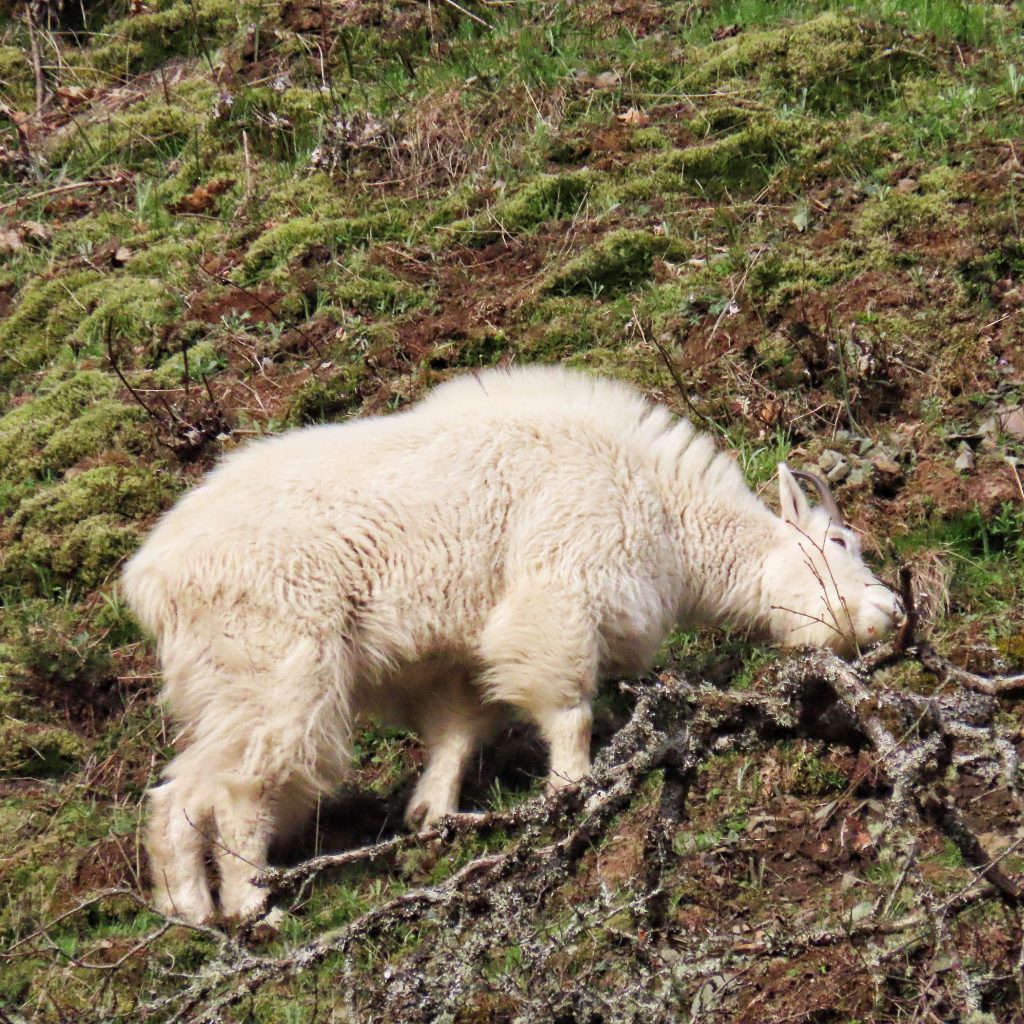
Oreamnos americanus is unusual amongst polygamous mammals in that the males defer to the females. Even during the courtship displays they are submissive, with males crawling to the females and bleating like kids. And once mating is accomplished the female usually drives the male from her territory. In fact nannies are more aggressive in general than the males, and more often resort to physical violence.
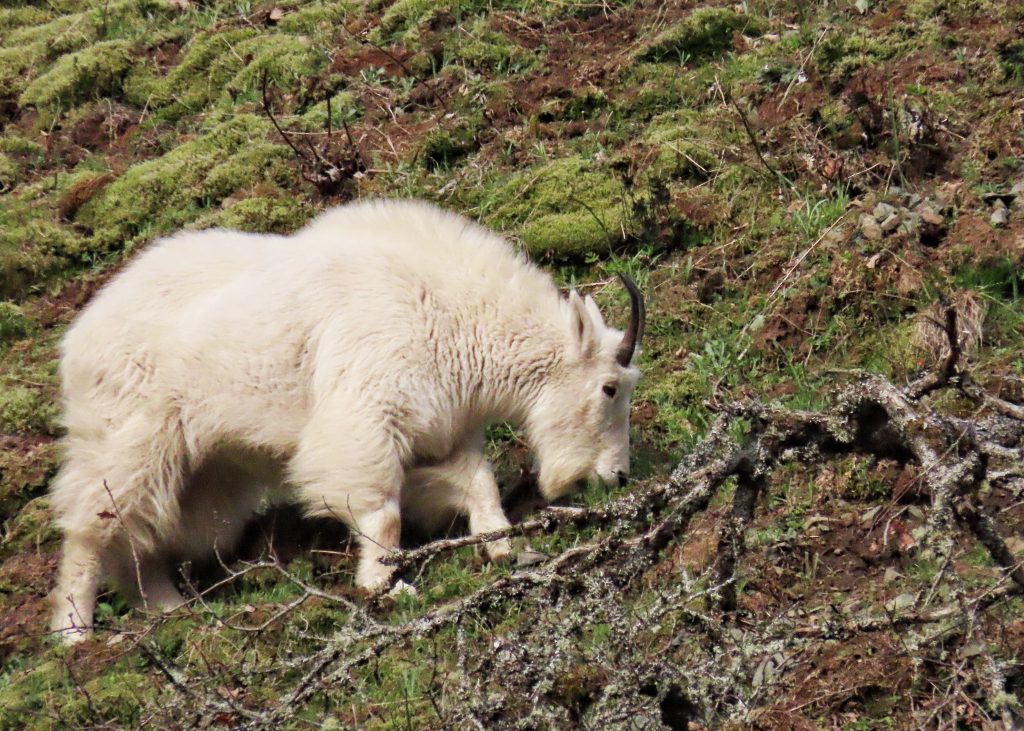
To accommodate the large temperature fluctuations between summer and winter in their mountain territories, Mountain Goats shed much of their wool during the warmer months, and regrow it in the fall. To accomplish this they must synthesize cysteine and methionine, amino acids which are vital to their hair growth. They must therefore obtain inorganic sulfur, as well as other minerals and salts which are lacking in their usual diet, at salt licks, most of which are located outside of their comfort zones of steep, open, rocky slopes.
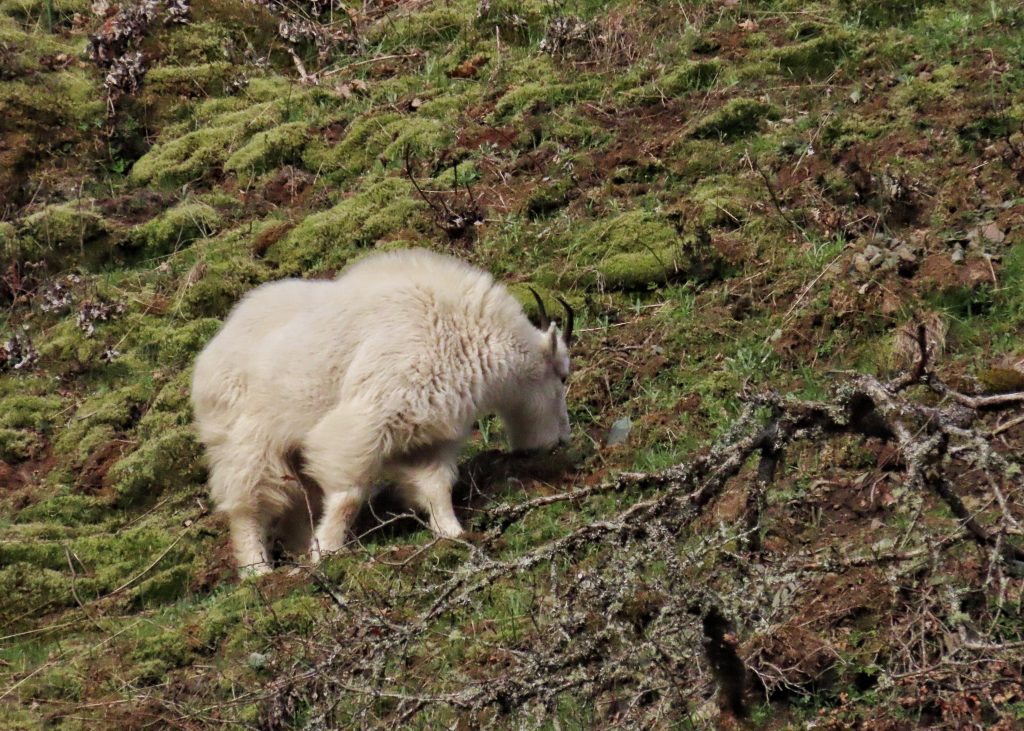
There have been several successful and ecologically sound attempts to reintroduce Mountain Goats in their historic range. One introduction was very successful, but not ecologically responsible, and that was their introduction into the Olympic Mtns. But they are not native to the Olympics, and were introduced in the 1920s by a hunting group. Because they aren’t native and they are doing great damage to rare and/or endemic species, they are being removed. A total of 412 Mountain Goats have now been removed, with 325 of those relocated to the North Cascades, where they are a native species.
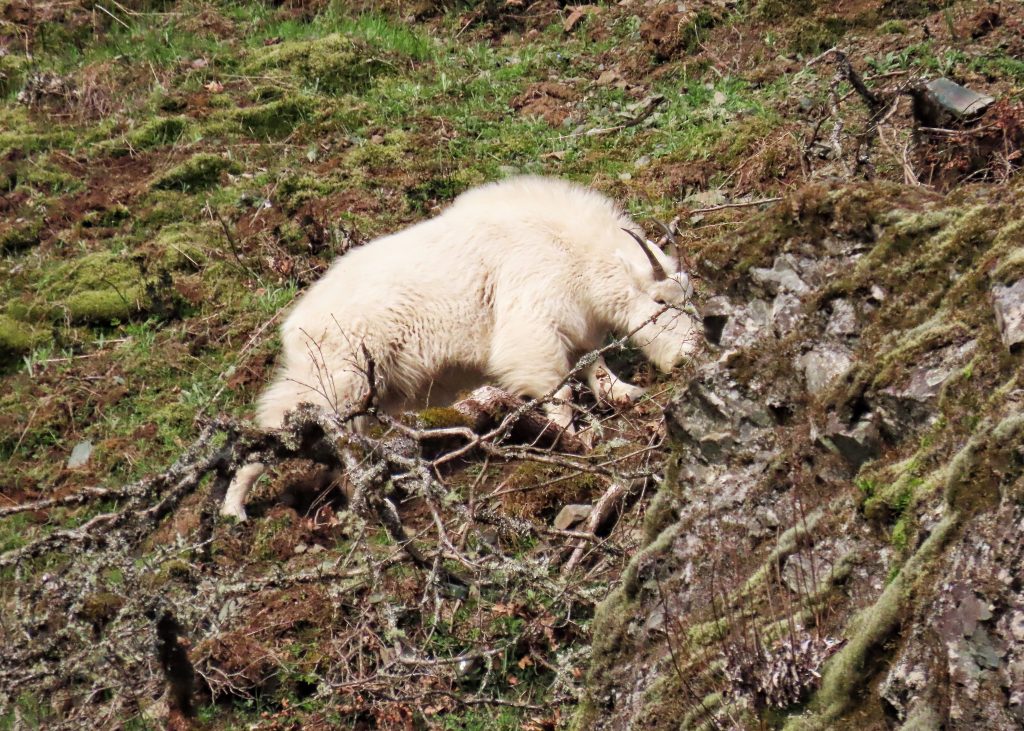
Description-Large (up to 3.5’ tall, up to 6’ long, up to 200 lbs), white, cloven hooved mammals (Artiodactyla), with black unbranched horns (which, as opposed to antlers, are never shed, and that can be used to figure out the age of the animal due to yearly growth rings), and black hooves.Males are taller and heavier than females, once they’ve reached sexual maturity. Females have narrower horns which are more widely spaced apart. Both sexes have beards.
Similar species-Nothing on this continent.
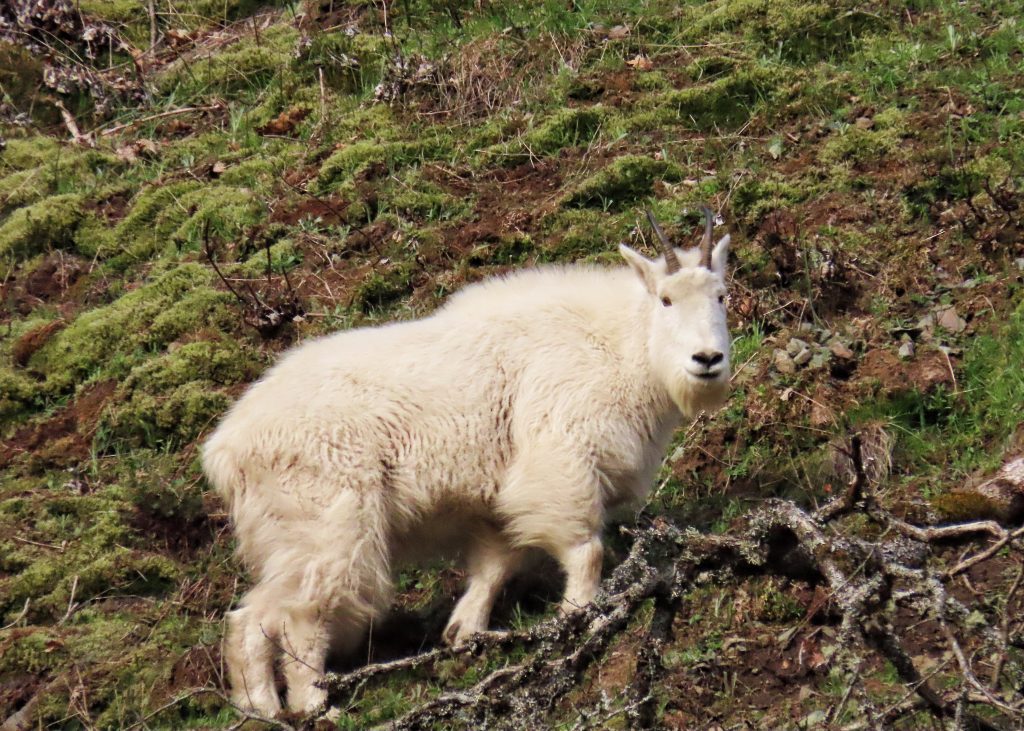
Habitat– Steep, rocky slopes, often with cliffbands. Most are found in subalpine to alpine areas, but there are some populations in BC in coastal forests, and they often migrate to below tree line in winter, as well as descending to lower elevation in late summer/fall in search of salt licks. Historically they were found in the Columbia River Gorge, most of which is under 2000’.
Range-Northwestern North America; found in the Cascades, Rockies, Blues, and Wallowas in our region, as well as isolated individuals in the Columbia River Gorge, such as the one shown here.
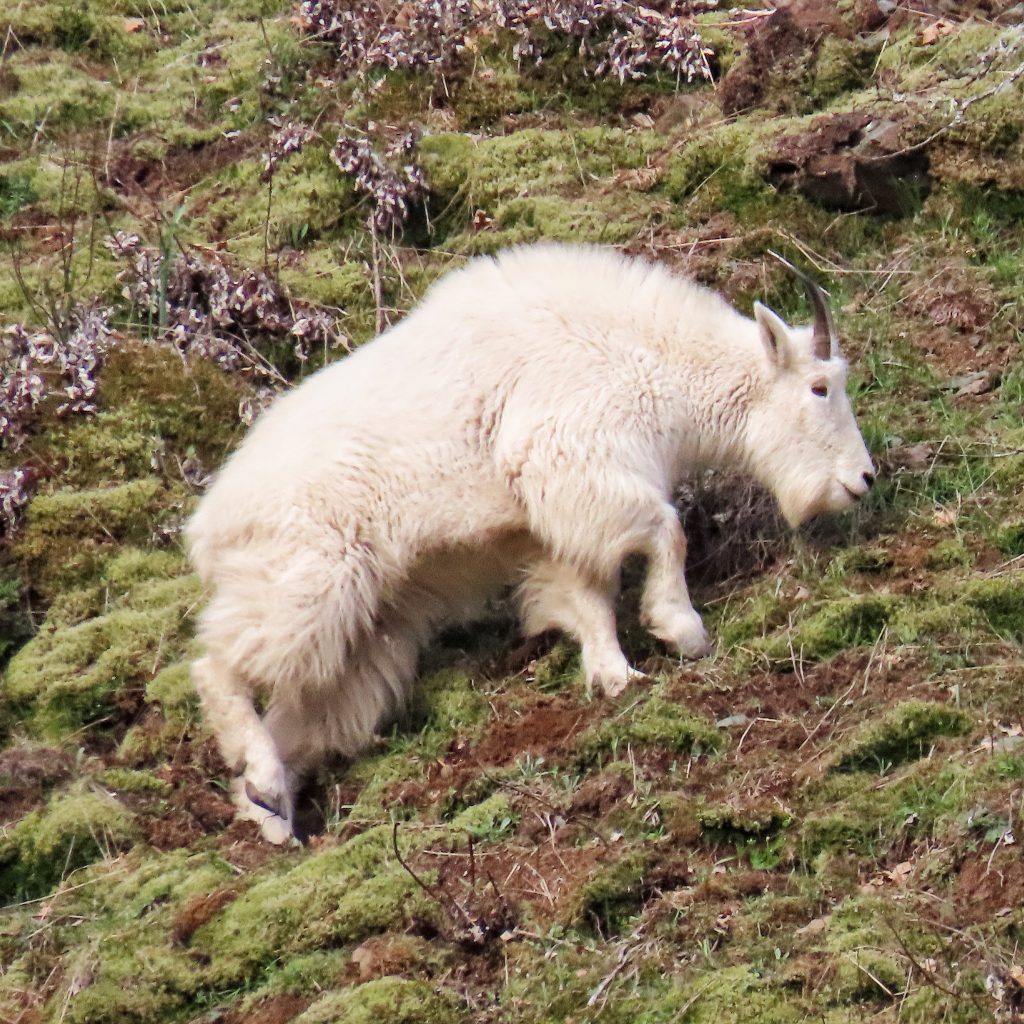
Eats-Grasses, lichens, mosses, and herbaceous and woody vegetation; because much of their browse is mineral poor they are frequently found near salt licks; the fact that humans are reservoirs of salt, leaving deposits in their sweat and urine, as well as purveying it in their food, is the cause of many less than peaceful encounters between the species in areas where the goats have lost their fear of people.
Eaten by-Golden eagles prey on the kids, as do bears, bobcats and cougars when they can get to them. Cougars and humans are the primary predators of adults.
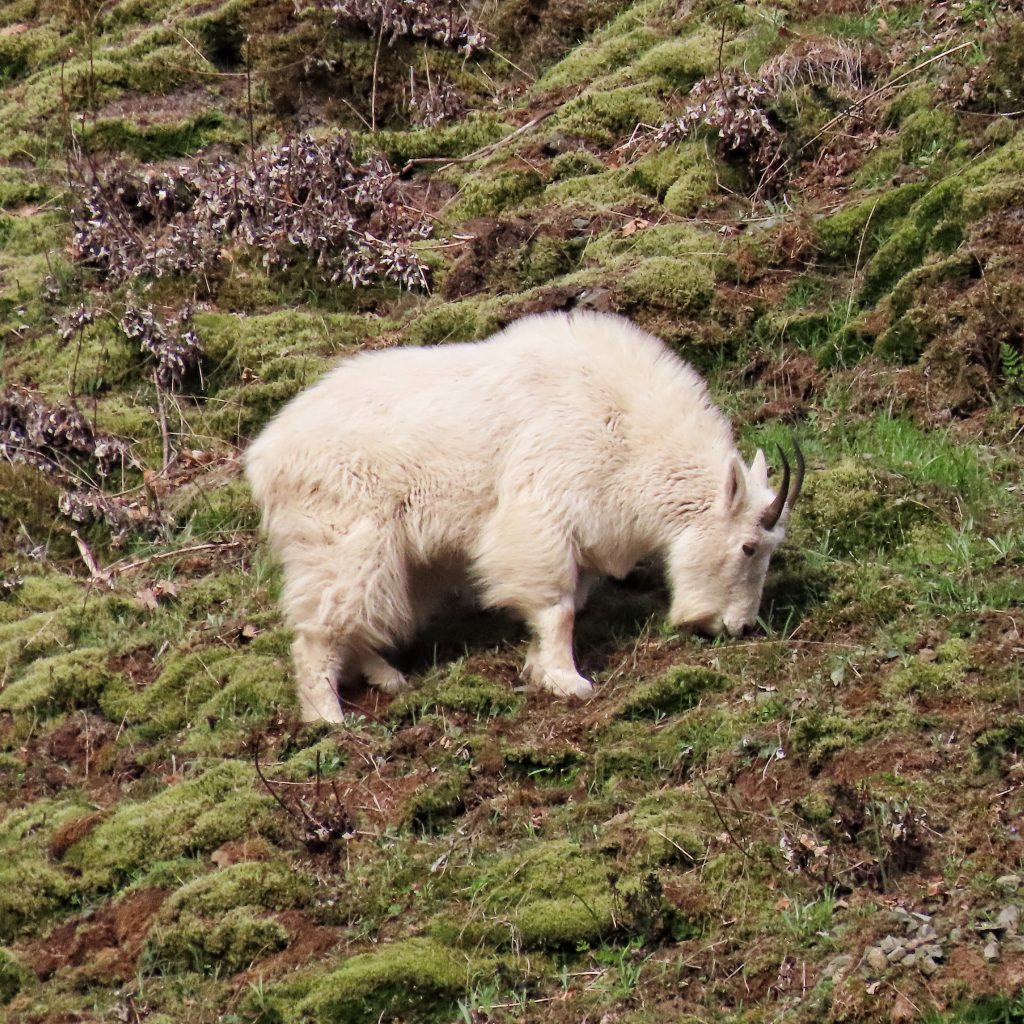
Reproduction-Mating takes place in November-December and 1or 2 (usually 1) kids are born April to June. Young are typically weaned at 4 months, and stay with their mothers until the next kids are born. Goats of both sexes become sexually mature after their 3rd summer. Nannies birth their kids in the most inaccessible parts of their range, and the kids are able to climb within days.
Adults active– Year around.
Etymology of names– Oreamnos is from Greek and translates roughly as ‘mountain lamb’. The specific epithet americanus refers to the fact that this species is native only to North America.
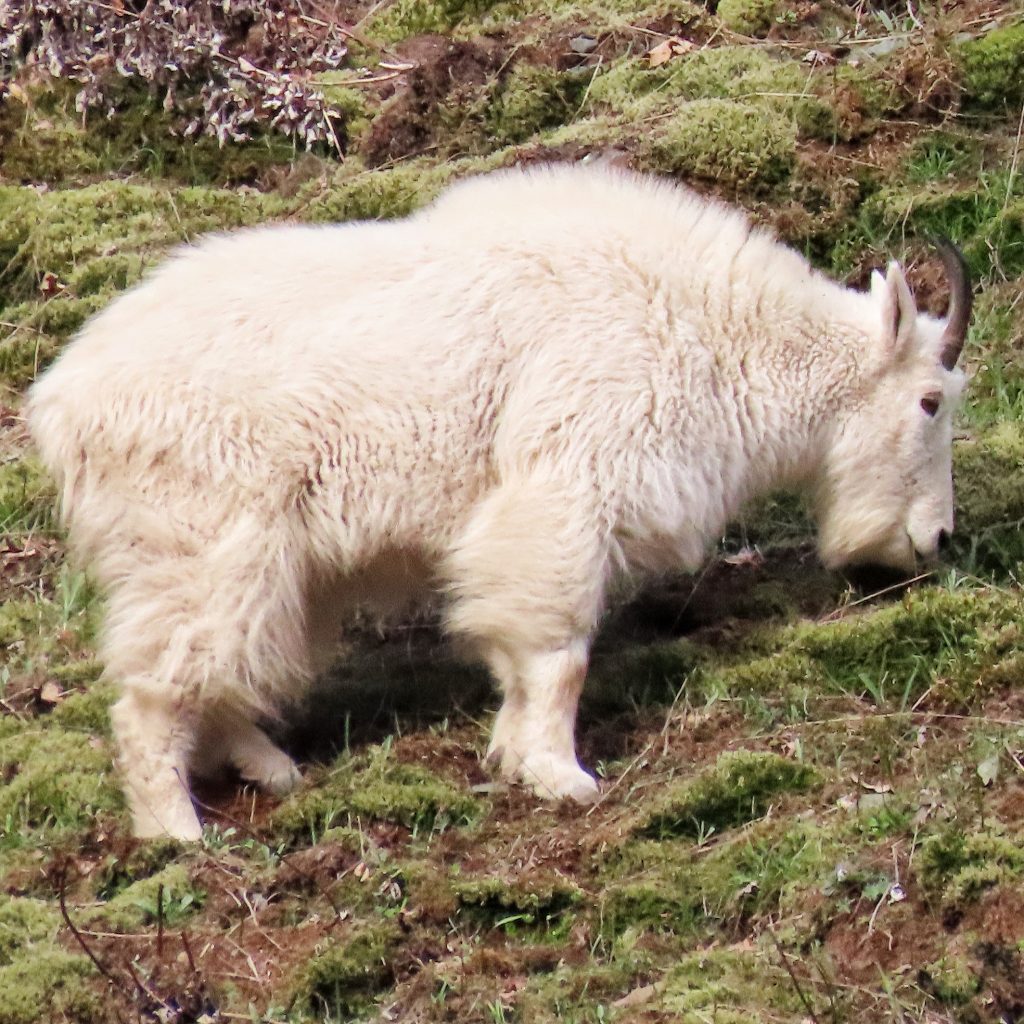
https://wdfw.wa.gov/species-habitats/species/oreamnos-americanus
https://api.nationalgeographic.com/distribution/public/amp/animals/mammals/facts/mountain-goat
https://www.britannica.com/animal/mountain-goat
https://www.fs.fed.us/database/feis/animals/mammal/oram/all.html
ADW: Oreamnos americanus: INFORMATION
https://en.m.wikipedia.org/wiki/Mountain_goat
https://www.oregonhikers.org/forum/viewtopic.php?t=21684
https://www.sciencedirect.com/science/article/pii/S0944200616300514
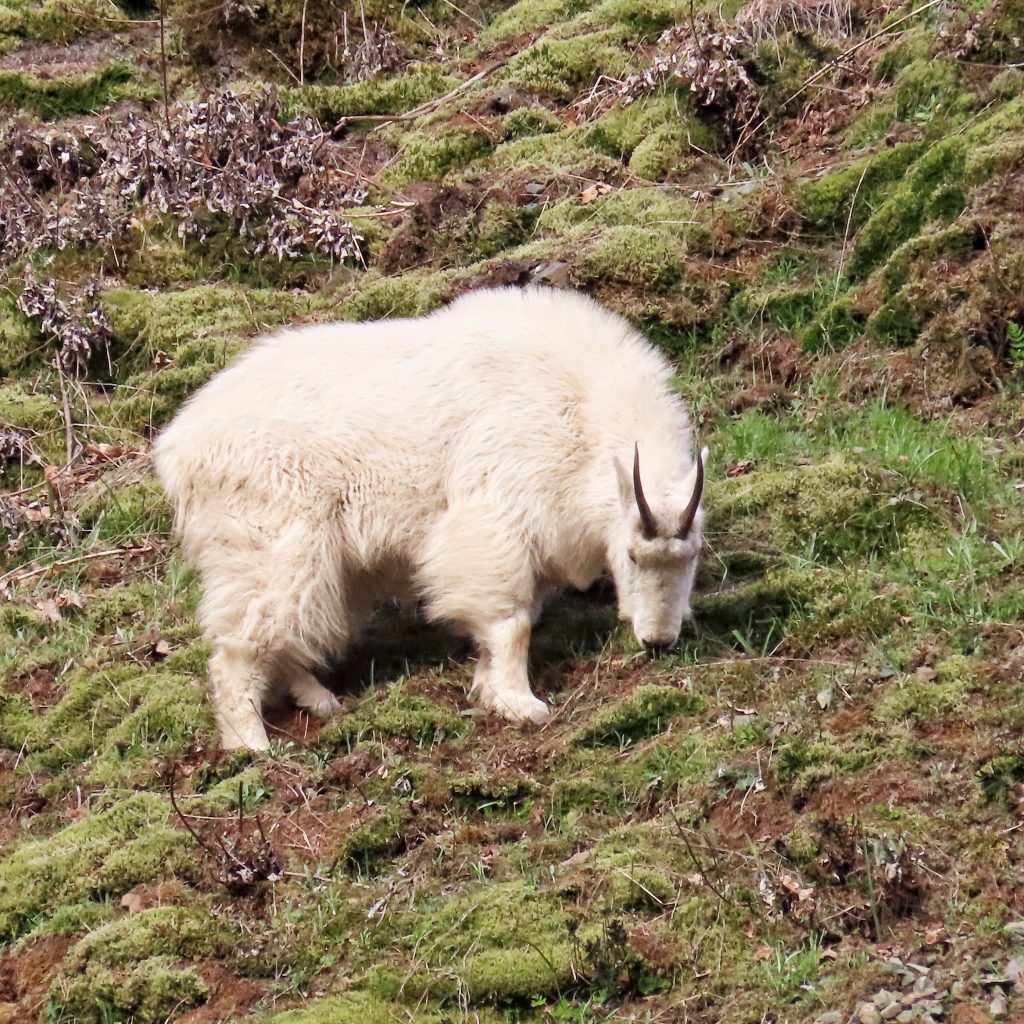
An amazing animal – thanks for all the info. I had heard about that hiker being gored and bleeding out, and the fact that they are being relocated. But indeed sad that this one has ended up all alone – is there any info on how she got there?
Not that I can find, and the wildlife biologist that was contacted couldn’t hazard a guess.
Wonderful, I’m glad you got to see her, These are one of my very favorite Alaskan creatures. We are privileged to be able to see them from boats (where no silly human can approach close enough to be gored). The females come down to the ocean’s edge to feed on kelps and regain their supply of salts after a less nutritious winter diet. They give birth at the bottom of a cliff face on the oceans edge, suitable protection from wolves and bears. Two weeks after birth the kid works it’s way back up what appears as sheer rock wall with its Mom just behind and they seek out other females and kids in the alpine, joining the band for summer.
Thank you for sharing your experience. I can see them in my minds eye!
It’s seems if she is solo, with all the other interference we do with Mammals, she should be relocated with others of her kind. How long has she been alone there?
I have no idea. I first heard about her late last fall.
I’ll make a point of looking next time I head south to the Gorge. I encountered several at Sunrise in MRNP last year and a few at Paradise. It’s always such a treat to see them up close. They seem pretty tame in herds and a respectful audience never seems unwelcome. Thanks for the great info !
When I went backcountry hiking in the Upper Enchanments, North Cascades in 2007 (I think?) we were warned by the Rangers that the mountain goats were particularly fond of hikers dirty underwear for the salt content and would tear your whole camp apart in search of them given the opportunity. So when leaving our base camp for the day we had to hang our food from trees because of bears and our soiled unmentionables because of the mountain goats. Fortunately neither animal was spotted near our camps, only from good safe distances.
Like having a bunch of frat boys around!
We often traveled on the Oregon side of the eastern Columbia Gorge when I was a kid in the late 50’s and early 60’s. I remember seeing them at least a couple of times. I think there were a couple of attempts at reintroduction, which didn’t stick. But perhaps one or two made it? That, or it’s a refugee from further north. I saw them a lot in Alaska and B.C.
According to someone at the Carson General Store/Backwoods Brewing, she hasn’t been seen lately. They are selling t-shirts with the name “Sweeney” and a mountain goat wearing shades. Hope she didn’t get poached.
Hopefully she just moved to higher ground with the warming weather🤞